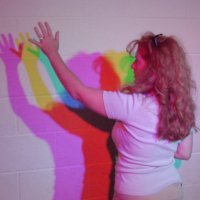 Imagine you’re a painter. What three colors do you need to make up any color in the universe? (You should be thinking: red, yellow, and blue… and yes, you are right if you’re thinking that the real primary colors are cyan, magenta, and yellow, but some folks still prefer to think of the primary colors as red-yellow-blue… either way, it’s really not important to this experiment which primary set you choose.)
Imagine you’re a painter. What three colors do you need to make up any color in the universe? (You should be thinking: red, yellow, and blue… and yes, you are right if you’re thinking that the real primary colors are cyan, magenta, and yellow, but some folks still prefer to think of the primary colors as red-yellow-blue… either way, it’s really not important to this experiment which primary set you choose.)
Here’s a trick question – can you make the color “yellow” with only red, green, and blue as your color palette? If you’re a scientist, it’s not a problem. But if you’re an artist, you’re in trouble already.
The key is that we would be mixing light, not paint. Mixing the three primary colors of light gives white light. If you took three light bulbs (red, green, and blue) and shined them on the ceiling, you’d see white. And if you could magically un-mix the white colors, you’d get the rainbow (which is exactly what prisms do.)
If you’re thinking yellow should be a primary color – it is a primary color, but only in the artist’s world. Yellow paint is a primary color for painters, but yellow light is actually made from red and green light. (Easy way to remember this: think of Christmas colors – red and green merge to make the yellow star on top of the tree.) It’s because you are using projection of light, not the subtrative combination of colors to get this result.
Here’s a nifty experiment that will really bring these ideas to life (and light!):
Materials:
- flashlight (three is best, but you can get by with two)
- fingernail polish (red, green, and blue)
- clear tape or cellophane (saran wrap works too)
- white wall space


Darker colors will cause the cellophane to absorb more energy, which causes the cellophane to heat up. Try holding the cellophane farther away from the headlight.
We colored cellophane with sharpies and put each color over a headlamp. The red caused the plastic to start melting so it was short-lived but a cool experiment. Any insight as to why that is?
Sure – give it a try! Permanent markers would work better.
Do Blue, Green and Red markers work for coloring too?
Primary colors are the sets of colors are combined to make a range of colors. The primary colors for a set depends on the medium. For example, in the world of light (like when projected lights or CRT displays), the three primary colors are red, green, and blue [RGB] as shown in this experiment.
Another set of primary colors used for printing (dyes) are cyan, magenta, and yellow [CMYK], although artists tend to prefer the set of red, yellow, blue [RYB]. This set is known as the subtractive combination.
What are primary colors?
We’re attaching a photo of the rainbow shadows we created today. I had some
gelatin photo filters from way back when (film days). We were able to make
yellow light from red and green, but the photo was too dim to send to you.
Needless to say, we’re enjoying the science lessons (confirming YES from
Xander)
This experiment works well in a dark room on a white wall. In this image (above in the experiment), I’ve used red, blue, and green party lights installed in flood lamp clip-on holders. Try using brighter flashlights and a darker room. Let me know how it goes!
Since we didn’t have blue, green, & red nail polish, we thought we’d try red, green, & blue sharpie permanent markers – although they did give off their respected color lights, when we put them together on a white wall, they did not mix to form white light, but continued to be separate colors…is it because we used sharpies or may it be because one flashlight was a bit stronger than the other? I guess I’m just wondering if it’s worth going out to get the colored nail polish if our flashlights are the issue – it seems like a great experiment!!!
Peggy